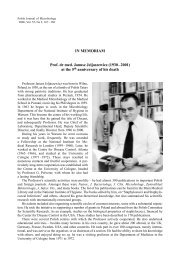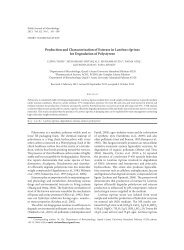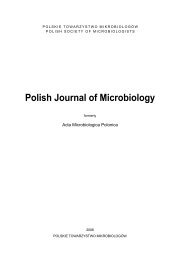No 3 - Polish Journal of Microbiology
No 3 - Polish Journal of Microbiology
No 3 - Polish Journal of Microbiology
Create successful ePaper yourself
Turn your PDF publications into a flip-book with our unique Google optimized e-Paper software.
184<br />
and Clarke, 2008). LTs have always been implicated in<br />
these processes. This topic has been very well reviewed<br />
by Scheurwater and Burrows (2011).<br />
Glycan strands <strong>of</strong> PG are also modified via the<br />
attachment <strong>of</strong> many different types <strong>of</strong> compounds and<br />
polymers to muramic acid, usually via a phosphodiester<br />
bond. The most notable <strong>of</strong> these are the teichoic and<br />
teichuronic acids as well as the arabinogalactans. Very<br />
rarely, structures are attached to GlcNAc, as in Streptococcus<br />
agalactiae. This topic is vast and well beyond the<br />
scope <strong>of</strong> this review.<br />
Even though the structure <strong>of</strong> PG and the various<br />
species-specific and function-determined modifications<br />
<strong>of</strong> its structural elements have been thoroughly<br />
investigated, there are still numerous unresolved fundamental<br />
questions regarding the architecture <strong>of</strong> the<br />
peptidoglycan, i.e. the orientation <strong>of</strong> the glycan strands<br />
and stem peptides in relation to the surface and axes <strong>of</strong><br />
a cell (Vollmer and Seligman, 2010). Various models<br />
for the spatial organization <strong>of</strong> peptidoglycan have been<br />
proposed over the years and currently two opposing<br />
models are considered: a model in which the glycan<br />
strands run parallel to the cytoplasmic membrane (the<br />
“classical” or “classical” model, e.g. Höltje, 1998; Pink<br />
et al., 2000) recently supported by experimental data<br />
by Gan et al. (2008) and Hayhurst et al. (2008) and<br />
the opposing “scaffold” model in which the glycan<br />
strands are oriented perpendicularly to the membrane<br />
(dmitriev et al., 2003, 2004, 2005; Meroueh et al., 2006).<br />
Unraveling the architectural issues is compounded<br />
by the differences <strong>of</strong> the thickness <strong>of</strong> PG in Gramnegative<br />
versus Gram-positive cells, which is approximately<br />
5–10 times thicker in the latter compared to<br />
the former and the fact that structure may be affected<br />
by i.e. growth conditions, gene activity (e.g. Höltje and<br />
Glauner, 1990; Vollmer et al., 2008; Korsak et al., 2005,<br />
2010; Cava et al., 2011), antibiotic production or resistance<br />
(Sieradzki and Markiewicz, 2004; Schaberle et al.,<br />
2011) and many other factors. Moreover, recent studies<br />
using cryo-transmission electron microscopy (cryo-EM)<br />
have conclusively demonstrated the existence <strong>of</strong> the<br />
equivalent <strong>of</strong> the Gram-negative periplasmic space in<br />
at least B. subtilis and Staphylococcus aureus (Matias and<br />
Beveridge, 2005; 2006), which also complicates interpretation<br />
in spatial structure studies. The technique<br />
reveals in Gram-positive bacteria two different cell<br />
wall layers: an inner wall zone (IWZ) <strong>of</strong> low-electron<br />
density, whose main component is lipoteichoic acid<br />
(Matias and Beveridge, 2008), and a high-electron<br />
density outer wall zone (OWZ). In the “layered” model<br />
the glycan strands are believed to run parallel to the<br />
plasma membrane, arranged as hoops or helices around<br />
the short axis <strong>of</strong> the cell, resulting in a woven fabriclike<br />
structure (Verwer et al., 1978; Vollmer and Höltje,<br />
2004; Vollmer et al., 2008). A recent study by Gan et al.<br />
(2008), in which frozen-hydrated sacculi from E. coli<br />
Markiewicz Z. and Popowska M. 3<br />
and Caulobacter crescentus were examined by electron<br />
cryotomography, confirmed the layered model, showing<br />
that in the Gram-negative PG sacculus a single layer<br />
<strong>of</strong> glycan strands lie parallel to the cell surface, roughly<br />
perpendicular to the long axis <strong>of</strong> the cell, encircling the<br />
cell in a disorganized hoop-like fashion. Their data also<br />
precluded the scaffold model. However, assuming that<br />
Gram-negative bacteria do have a single layer <strong>of</strong> PG, then<br />
how can one explain the difference in the thickness <strong>of</strong><br />
E. coli PG versus Pseudomonas aeruginosa PG (approximately<br />
2 : 1, respectively, for either dry or hydrated<br />
isolated sacculi (Vollmer and Seligman, 2010)? The<br />
organization <strong>of</strong> PG in ovococcoidal mutant Lactobacillus<br />
lactis cells lacking cell wall exopolysaccharides was<br />
studied using AFM (Atomic Force Microscopy) topographic<br />
and recognition imaging. Topographic images<br />
showed periodic ridges on the mutant surface that<br />
always ran parallel to the short cell axis. Recognition<br />
imaging demonstrated that these ridges consisted <strong>of</strong><br />
peptidoglycan. The results are consistent with a PG<br />
organization in the plane perpendicular to the long<br />
axis <strong>of</strong> the cell (Andre et al., 2010). It would thus seem<br />
that the 3-d architecture <strong>of</strong> PG in both Gram-negative<br />
and Gram-positive cells is <strong>of</strong> the layered type. However,<br />
observations <strong>of</strong> isolated Bacillus subtilis PG using AFM<br />
show that, at least in this species, spatial organization<br />
is more complex (Hayhurst et al., 2008). This may be<br />
related to the existence <strong>of</strong> the IWZ in B. subtilis (Matias<br />
and Beveridge, 2005; Zuber et al., 2006) and the finding<br />
that the glycan strands <strong>of</strong> the bacterium are longer<br />
50 times longer than previously calculated. The model<br />
<strong>of</strong> Hayhurst et al. (2008) proposes that during biosynthesis<br />
small numbers <strong>of</strong> glycan strands are polymerized<br />
and cross-linked to build a peptidoglycan “rope”, which<br />
is coiled into a helix to form inner surface cable structures.<br />
The nascent helix (cable) is inserted into the cell<br />
wall by cross-links between two existing cables and the<br />
overlying cable interface cleaved by autolysins known<br />
to be essential for cell growth. As part <strong>of</strong> cable maturation,<br />
the structure may become stabilized by inter/intra<br />
glycan strand cross-links. The model also predicts that<br />
the cell wall is likely only one intact cable thick with<br />
partially hydrolyzed cables also present externally. Solid-<br />
state NMR data obtained for Staphylococcus aureus PG,<br />
which contains an interpeptide pentaglycyl bridge, show<br />
that the spatial arrangement <strong>of</strong> the polymer in staphylococci<br />
may be even more complex. Partial charac-<br />
terization <strong>of</strong> the structure was achieved by measuring<br />
spin diffusion from (13) C labels in pentaglycyl crosslinking<br />
segments to natural-abundance (13) C in the<br />
surrounding intact cell walls. The measurements were<br />
performed using a version <strong>of</strong> Centerband-Only detection<br />
<strong>of</strong> Exchange (COdEx). The COdEx spin diffusion<br />
rates established that the pentaglycyl bridge <strong>of</strong> one<br />
peptidoglycan repeat unit <strong>of</strong> S. aureus is within 5 angstroms<br />
<strong>of</strong> the glycan chain <strong>of</strong> another repeat unit, which






